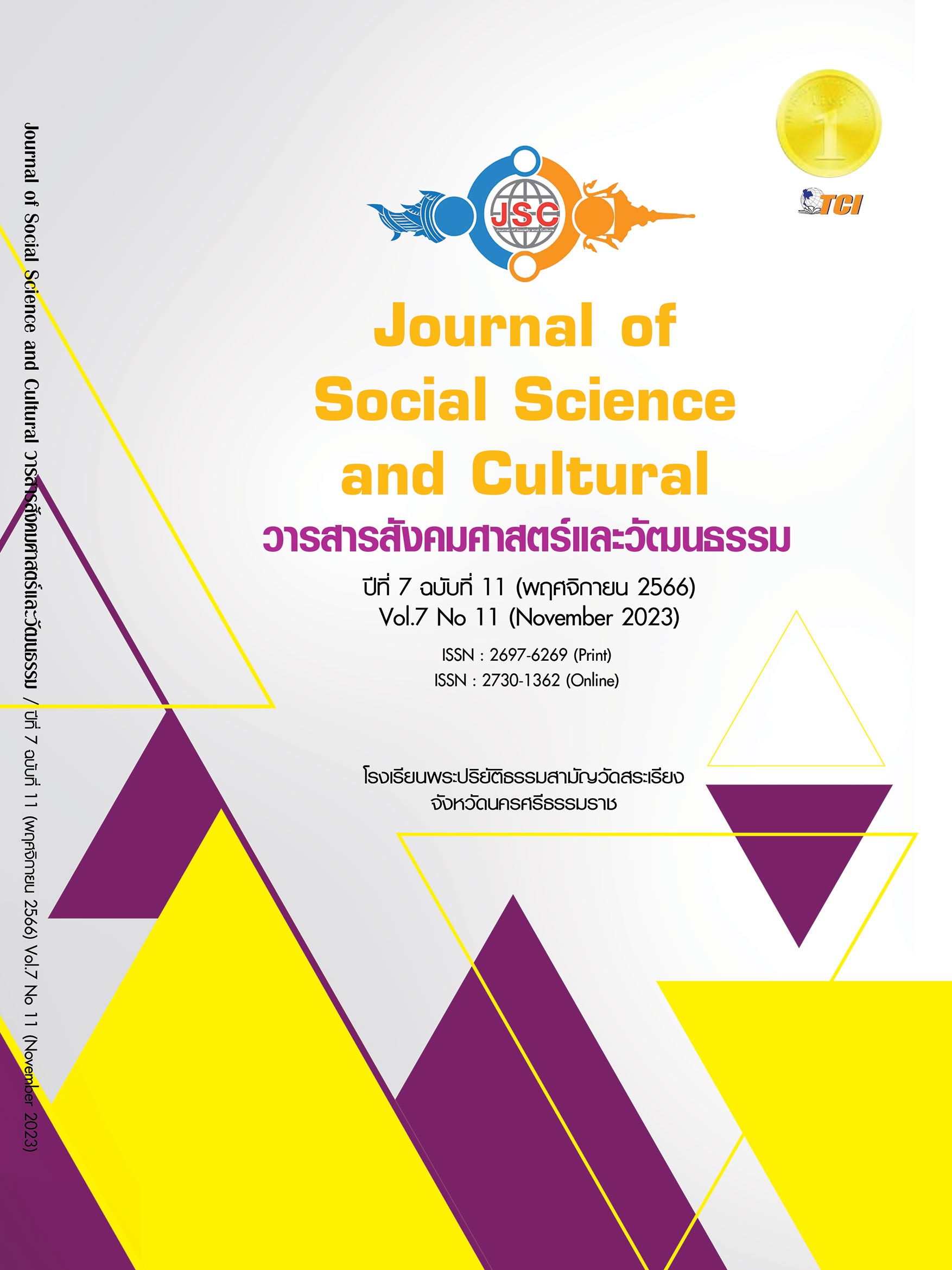THE STUDY OF CORPORAL PUNISHMENT IN CHILDREN AMONG PARENTS OF DIFFERENT GENERATIONS
Main Article Content
Abstract
The objective of this study was to examine attitudes, behaviors, causes, and effects of corporal punishment in children of different age groups. In-depth interviews were conducted with 3 age groups: 1) 4 baby boomers, 2) 8 Generation X, and 3) 8 Generation Y, totaling 20 people. Synthesize content data and examine it with triangular techniques. The results showed that most baby boomers believed corporal punishment was still beneficial, but other forms of punishment should be reduced instead. The causes of punishment are the child's behavior, the experience of the caregiver, and the punishment has affected the child's body. Most Generation X nurturers believe that corporal punishment is something that should be used and used in conjunction with other forms of punishment. Most Generation Y caregivers believe that corporal punishment can still work if other methods do not work. The reasons for punishment are the child's behavior and the caregiver's experience, and the punishment affects the child both physically and mentally. The results showed that the attitudes of baby boomers saw the importance of corporal punishment the most, but in practice it was less used than other groups. The causes of punishment for all 3 ages are the child's behavior and the experience of the caregiver. Generation Y states that physical punishment is required because they do not know how to punish other forms of punishment. Nurturers of all 3 ages see punishment as having an impact on both body and mind.
Article Details
References
กนกพร กลิ่นดอกแก้ว และอดิพล เอื้อจรัสพันธุ์. (2565). ความรุนแรงเชิงวัฒนธรรม: ภาพสะท้อนการถูกกดทับจากการเรียนรู้ทางสังคมในสังคมไทย. วารสารสุทธิปริทัศน์, 36(1), 1-24.
กลุ่มอายุ 39 - 59 ปี คนที่ 2 ชาย. (21 กันยายน 2564). การศึกษาการลงโทษทางร่างกายในเด็กของผู้เลี้ยงดูต่างช่วงวัย. (กนกวรรณ รุจนเวชช์, ผู้สัมภาษณ์)
กองส่งเสริมสถาบันครอบครัว. (2564). สถิติความรุนแรงในครอบครัว ประจำปี 2564. กรมกิจการสตรีและสถาบันครอบครัว กระทรวงการพัฒนาสังคมและความมั่นคงของมนุษย์. เรียกใช้เมื่อ 11 มกราคม 2565 จาก https://opendata.nesdc.go.th/dataset/https-drive-google-com-file-d-16qsyunvqmzxnm4 krc_5xee_zoxffxmg4-view-usp-sharing
จิรังกูร ณัฐรังสี และคณะ. (2563). ก้าวข้ามความรุนแรงสู่การใช้วินัยเชิงบวกในการแนะแนวทางเด็กและเยาวชน. วารสารอเวชสารแพทย์ทหารบก, 73(3), 173-179.
นญา พราหมหันต์. (2560). ทายาทความรุนแรง: แนวคิดการประกอบสร้างทางสังคมต่อการจัดการประสบการณ์ความรุนแรง. ใน วิทยานิพนธ์มหาบัณฑิต สาขาวิชาอาชญาวิทยาและงานยุติธรรม. จุฬาลงกรณ์มหาวิทยาลัย.
นิธิชญา ใจเย็น. (2563). ความสัมพันธ์ระหว่างภาษากับอุดมการณ์ในวาทกรรมแนะนำวิธีการเลี้ยงลูกโดยแพทย์ผู้เชี่ยวชาญเฉพาะทาง: การศึกษาแนววาทกรรมวิเคราะห์เชิงวิพากษ์. ใน วิทยานิพนธ์ดุษฎีบัณฑิต สาขาวิชาภาษาไทย. จุฬาลงกรณ์มหาวิทยาลัย.
บุญเลิศ โพธิ์ขำ. (2559). ปัญหาของกฎกระทรวงกำหนดความประพฤติของนักเรียนและนักศึกษา พ.ศ. 2548 ออกตามพระราชบัญญัติคุ้มครองเด็ก พ.ศ. 2546. Nakhon Phanom University Journal, 6(2), 78-86.
ผู้ให้ข้อมูลในกลุ่มอายุ 15 - 38 ปี คนที่ 2 ชาย. (25 สิงหาคม 2564). การศึกษาการลงโทษทางร่างกายในเด็กของผู้เลี้ยงดูต่างช่วงวัย. (กนกวรรณ รุจนเวชช์, ผู้สัมภาษณ์)
ผู้ให้ข้อมูลในกลุ่มอายุ 15 - 38 ปี คนที่ 5 หญิง. (22 สิงหาคม 2564). การศึกษาการลงโทษทางร่างกายในเด็กของผู้เลี้ยงดูต่างช่วงวัย. (กนกวรรณ รุจนเวชช์, ผู้สัมภาษณ์)
ผู้ให้ข้อมูลในกลุ่มอายุ 15 - 38 ปี คนที่ 5 หญิง. (25 สิงหาคม 2564). การศึกษาการลงโทษทางร่างกายในเด็กของผู้เลี้ยงดูต่างช่วงวัย. (กนกวรรณ รุจนเวชช์, ผู้สัมภาษณ์)
ผู้ให้ข้อมูลในกลุ่มอายุ 15 - 38 ปี คนที่ 7 หญิง. (22 สิงหาคม 2564). การศึกษาการลงโทษทางร่างกายในเด็กของผู้เลี้ยงดูต่างช่วงวัย. (กนกวรรณ รุจนเวชช์, ผู้สัมภาษณ์)
ผู้ให้ข้อมูลในกลุ่มอายุ 39 - 59 ปี คนที่ 1 ชาย. (21 กันยายน 2564). การศึกษาการลงโทษทางร่างกายในเด็กของผู้เลี้ยงดูต่างช่วงวัย. (กนกวรรณ รุจนเวชช์, ผู้สัมภาษณ์)
ผู้ให้ข้อมูลในกลุ่มอายุ 39 - 59 ปี คนที่ 4 ชาย. (22 สิงหาคม 2564). การศึกษาการลงโทษทางร่างกายในเด็กของผู้เลี้ยงดูต่างช่วงวัย. (กนกวรรณ รุจนเวชช์, ผู้สัมภาษณ์)
ผู้ให้ข้อมูลในกลุ่มอายุ 39 - 59 ปี คนที่ 5 หญิง. (21 กันยายน 2564). การศึกษาการลงโทษทางร่างกายในเด็กของผู้เลี้ยงดูต่างช่วงวัย. (กนกวรรณ รุจนเวชช์, ผู้สัมภาษณ์)
ผู้ให้ข้อมูลในกลุ่มอายุ 60 - 77 ปี คนที่ 2 ชาย. (20 พฤศจิกายน 2564). การศึกษาการลงโทษทางร่างกายในเด็กของผู้เลี้ยงดูต่างช่วงวัย. (กนกวรรณ รุจนเวชช์, ผู้สัมภาษณ์)
ผู้ให้ข้อมูลในกลุ่มอายุ 60 - 77 ปี คนที่ 3 หญิง. (20 พฤศจิกายน 2564). การศึกษาการลงโทษทางร่างกายในเด็กของผู้เลี้ยงดูต่างช่วงวัย. (กนกวรรณ รุจนเวชช์, ผู้สัมภาษณ์)
ผู้ให้ข้อมูลในกลุ่มอายุ 60 - 77 ปี คนที่ 4 หญิง. (20 พฤศจิกายน 2564). การศึกษาการลงโทษทางร่างกายในเด็กของผู้เลี้ยงดูต่างช่วงวัย. (กนกวรรณ รุจนเวชช์, ผู้สัมภาษณ์)
ลือรัตน์ อนุรัตน์พานิช. (2559). เจนเอ็กซ์ เจนวาย เจนแซด คืออะไร. บทความเผยแพร่ความรู้สู่ประชาชน. เรียกใช้เมื่อ 21 เมษายน 2562 จาก https://pharmacy.mahidol.ac.th/th/knowledge/article /330/
ศรัณย์ศิริ คัมภิรานนท์. (2563). ความรุนแรงในครอบครัวของสังคมไทย. กรุงเทพมหานคร:: สำนักวิชาการ สำนักงานเลขาธิการวุฒิสภา.
สถาบันเพื่อการยุติธรรมแห่งประเทศไทย. (2563). Troubled Childhood III: ภูมิหลังการตกเป็นเหยื่อความรุนแรงของประชากรกลุ่มตัวอย่างอายุ 18 - 29 ปี (รายงานผลการวิจัย). กรุงเทพมหานคร: สถาบันเพื่อการยุติธรรมแห่งประเทศไทย.
สมคิด พุ่มทุเรียน และคณะ. (2566). จิตวิทยาเชิงพุทธกับการเสริมสร้างความมั่นคงทางครอบครัวพ่อแม่มือใหม่. วารสารวิจัยวิชาการ, 6(2), 335-346.
สำนักงานสถิติแห่งชาติ. (2563). โครงการสำรวจสถานการณ์เด็กและสตรีในประเทศไทย พ.ศ. 2562. (รายงานผลฉบับสมบูรณ์). กรุงเทพมหานคร: สำนักงานสถิติแห่งชาติ.
หัตถพันธ์ วงชารี. (2559). การพัฒนาและตรวจสอบมาตรวัดความเชื่อเกี่ยวกับการลงโทษทางร่างกายในสังคมไทย. ใน วิทยานิพนธ์มหาบัณฑิต สาขาวิชาจิตวิทยาพัฒนาการ. จุฬาลงกรณ์มหาวิทยาลัย.
หัตถพันธ์ วงชารี และคณะ. (2562). ความสัมพันธ์ระหว่างความเชื่อที่ผิดเกี่ยวกับการลงโทษทางร่างกายกับแนวโน้มการใช้การลงโทษทางร่างกาย. วารสารสังคมศาสตร์และมนุษยศาสตร์, 45(1), 341-365.
Ali, A., et al. (2019). Psychological Trauma and Corporal Punishment. Global Social Sciences Review (GSSR), 4(2), 138-147.
Bell, T. & Romano, E. (2012). Opinions About Child Corporal Punishment and Influencing Factors. Journal of Interpersonal Violence, 27(11), 2208-2229.
Breen, A., et al. (2015). Children's experiences of corporal punishment: A qualitative study in an urban township of South Africa. Child Abuse & Neglect, 48, 131-139. https://doi.org/10. 1177/0886260511432154.
Fakunmoju, S. B. (2022). Perception and abolition of corporal punishment among a sample of respondents in southwest Nigeria. Child abuse review, 31(1), 40-53.
Fréchette, S. & Romano, E. (2017). How do parents label their physical disciplinary practices? A focus on the definition of corporal punishment. Child Abuse & Neglect, 71, 92-103. https://doi.org/10.1016/j.chiabu.2017.02.003.
Ganapathy, S. S., et al. (2022). Practice of Disciplinary Methods and Factors Associated With Belief for Physical Punishment Among Malaysian ParentsFindings From NHMS 2016. Global Pediatric Health, 9, 1-9. https://doi: 10.1177/2333794X221113820journals. sagepub.com/ home/gph.
Global report 2019. (2020). Progress towards ending corporal punishment of children Registered charity no. 328132. London: Global Initiative to End All Corporal Punishment of Children.
Le, K. & Nguyen, M. (2019). “Bad Apple” peer effects in elementary classrooms: the case of corporal punishment in the home. Education Economics, 27(6), 557-572.
Mahlangu, P., et al. (2021). Prevalence and factors associated with experience of corporal punishment in public schools in South Africa. PLoS ONE, 16(8). https://doi.org/10. 1371/journal.pone.0254503.
UNICEF Publications. (2017). A Familiar Face: Violence in the lives of children and adolescents. New York: United Nations Children’s Fund (UNICEF).
Utter, M. (2020). Opposing Viewpoints: Corporal Punishment in the Home and Its Affects on Children. Children's Legal Rights Journal, 39(3), 309-314.
Wang, F., et al. (2018). Attitudes mediate the intergenerational transmission of corporal punishment in China. Child Abuse & Neglect, 76, 34-43. doi: 10.1016/j.chiabu.2017 .10.003.
Wang, M., et al. (2018). Intergenerational Transmission of Corporal Punishment: The Independent and Interactive Moderating Role of Children’s Negative Affectivity and Effortful Control. Journal of Interpersonal Violence, 36(9-10), 1-23.
Ward, K. P., et al. (2021). Multilevel ecological analysis of the predictors of spanking across 65 countries. BMJ Open, 11(8), 1-8.
Wolf, S. & Suntheimer, N. M. (2020). Predictors of parental disciplinary practices and associations with child outcomes among Ghanaian preschoolers. Children and Youth Services Review, 112, 1-10. https://doi.org/10.1016/j.childyouth.2019.104518.


